MALI
Population

Population
Population
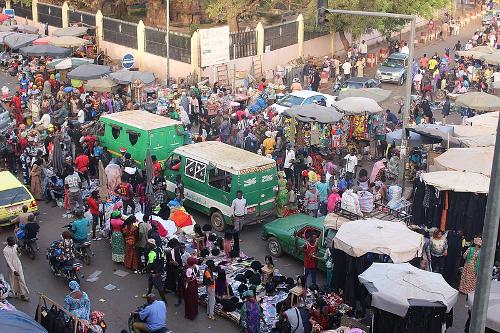 Malians visit the market in Bamako, MaliPhoto: Carolinerre CC 4.0 International no changes made
Malians visit the market in Bamako, MaliPhoto: Carolinerre CC 4.0 International no changes made
Mali has 22 million inhabitants. (2024) This means that approximately 18 inhabitants live per km2. Furthermore, for economic reasons, more than three million Malians live in Ivory Coast, France and other neighboring countries of Mali. 46% of the population lives in cities, the rest in rural areas. Almost 30% of the population lives in the humid, fertile south (Niger river basin). This percentage increases due to the migration from the countryside to the city, a migration mainly caused by the persistent drought, which affected the country in the 1980s. The largest and most important city is the capital Bamako with more than 1 million inhabitants. The entire agglomeration of Bamako has approximately 3 million inhabitants. Much smaller are cities such as Ségou, Mopti, Sikasso, Gao, Kayes, San and Koutiala. The countryside in the north is virtually unpopulated. Most people live in the south and along the Niger. Population growth has been around 3 percent in recent years (2024: 2.9%). The birth rate was 40 per 1000 inhabitants in 2017, the death rate was 8.1. Mali has a very young population. The percentage of inhabitants between 0-14 years was 46.8% in 2024, between 15-64 years 50.1% and 65+ 3.1%. The average age is low. Life expectancy for men is 60.9 years and 65.6 years for women.
An overview of the main population groups:
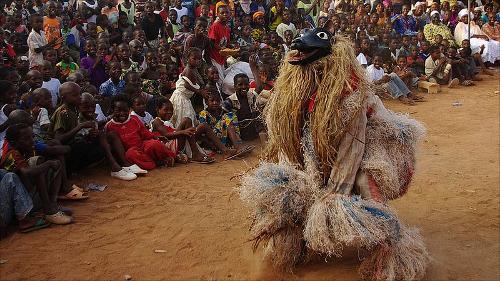 Bambara ritual dance, MaliPhoto: TRIP DOWN MEMORY LANE CC 4.0 no changes made
Bambara ritual dance, MaliPhoto: TRIP DOWN MEMORY LANE CC 4.0 no changes made
The Bambara are the largest population group in Mali. Mainly as arable farmers they live in Central and Southern Mali, where the largest cities of Bamako and Ségou are also located. The Malinké and the Soninké or Marka live in Western Mali and are closely related to the Bambara. The Bambara, Soninké and Malinké are together also called Mandé or Manding. These peoples were the founders of the great West African empires. At the moment, they dominate politics and the economy by their sheer numbers. The Bambara are moderate Muslims, quite modern and as a result many old customs and rituals have been lost. Only much of the early music remains. These musicians are called griots or jali's and are still highly regarded today.
The Bozo are probably the oldest people in Mali. They are a people of fishermen and boat builders. They generally live in small elongated villages along the Niger. A brother people of the Bozo are the Somono.
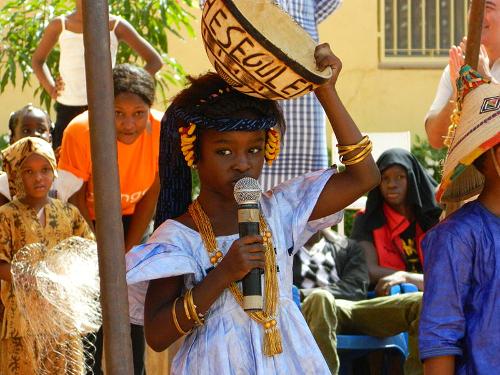 Girl in traditional Peul clothes, MaliPhoto: Rgaudin in the public domain
Girl in traditional Peul clothes, MaliPhoto: Rgaudin in the public domain
The Peul are also called Fula, Fulani and Fulbe. These livestock keepers live in large parts of West Africa and in Mali in and around the Niger Delta. From the eighteenth century onwards, this people was oppressed by the agricultural activities of other nations and by the high taxes. They fiercely oppose this through jihads (holy wars). They then founded Islamic states, including Masina with Djenné as its capital. In December, the Peul with tens of thousands of head of cattle cross the Niger from the north bank to the south bank.
The Songhai mainly live in East Mali (including Timbuktu, Gao, Hombori). Formerly fishermen and hippo hunters and now arable farmers. They mainly grow millet and sorghum and in the wet season also rice. Their culture is mainly determined by Islam.
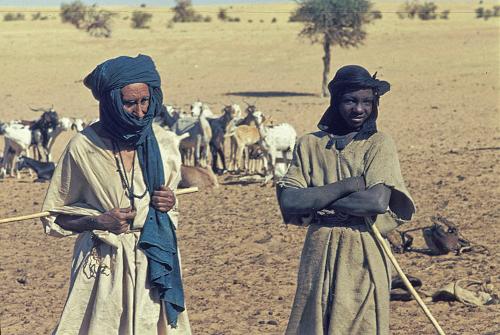 Tuareg MaliPhoto: H Grobe CC 3.0 Unported no changes made
Tuareg MaliPhoto: H Grobe CC 3.0 Unported no changes made
The Tuareg live in the northern Malian desert area. They are the southernmost Berber people and mainly live in southern Algeria and northern Niger. They speak Tamasheq, a Berber language. They lead a nomadic life as pastoralists. The Tuareg are also Muslims, but with some deviating characteristics. For example, they are strictly monogamous and women play an important role. Furthermore, the men are veiled and the women are not. Due to the prolonged dry spells in the 1970s and 80s of the 20th century, they lost almost all their livestock. In the early 1990s, this led to a civil war between the Tuareg and the Malian government army.
The Moors are nomadic Arabs who travel through the Sahara and the Sahel with their livestock. Most Moors live in Mauritania and in Mali they live mainly along the Mauritanian border and around Timbuktu.
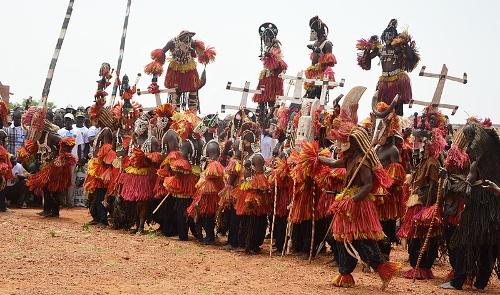 Dogon, Dance of the Masks, MaliPhoto: Fasokan CC 4.0 International no changes made
Dogon, Dance of the Masks, MaliPhoto: Fasokan CC 4.0 International no changes made
The Dogon are the most famous people of Mali. The influence of Islam and Christianity is virtually nil, so the Dogon can still maintain their traditional animist lifestyle. Initially they settled on the Niger, near present day Bamako. In the 15th century they were forced to leave by advancing Muslim peoples. They then settled along the Falaise de Bandiagara, a 200 kilometer long gorge wall in southeastern Mali. They are arable farmers and grow, among other things, millet, sorghum, tomatoes and onions. The onions are dried and then traded, the other products are for personal use. A typical Dogon product is "dolo", millet beer, which is even drunk by children. The Dogon also have livestock, which, however, is cared for by the Peul because the Dogon think that this is inferior work. The Dogon community is divided hierarchically into a number of social groups. The most important group are the farmers, followed by the blacksmiths, weavers and leather workers. There are no marriages between the different groups. The women who belong to these groups also have their own activities. The Dogon believe in one god, Amma, and know several sacred animals, such as the leopard, crocodile, and fox. One of the most important mysterious events in the Dogon's life is the circumcision of both boys and girls (clitoridectomy). This in Western eyes barbaric custom is maintained by almost all Malian population groups. Female circumcision has declined in the cities in recent years, partly due to protests from abroad. On many occasions there is dancing by the young men accompanied by singing men with drums. They all wear masks, often animal figures. The dancers on stilts are very special. The most important ritual is the "sigui". This ceremony takes place once every sixty years (next generation celebration is in 2025) and marks the beginning of a new generation. Determining the date is the position of a satellite of the star Sirius, Sirius B. All the customs, rituals and secrets of the Dogon are then passed on to the younger generation. A few smaller groups live in the south of the country, including Sénufo, Minianka, Bobo and Mossi.
Sources
Te gast in Mali
Verre Reizen
Velton, R. / Mali
Bradt
Vlugt, B. / Mali
Gottmer
Westen, G. van / Mali : mensen, politiek, economie, cultuur
Koninklijk Instituut voor de Tropen
CIA - World Factbook
BBC - Country Profiles
Copyright: Team The World of Info